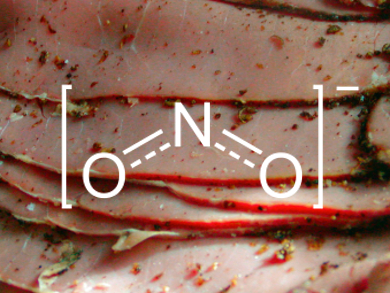Curing salt is a mixture of table salt and 0.5 to 1 % potassium and sodium nitrite. Alternatively, it can include also saltpeter, i.e., potassium and sodium nitrate. All four salts are approved food additives – nitrites, however, are only allowed for the curing of meat products and with a maximum concentration of 150 mg per kg of meat. Nitrates are also permitted for cheese and fish products to a maximum of 500 mg per kg.
The color of untreated meat quickly fades as the muscle pigment myoglobin is oxidized. Nitric oxide, which is formed from nitrite under acidic conditions, reacts with myoglobin to give the stable, red dye nitrosomyoglobin. Nitrates do the same via an intermediate step: microorganisms in meat turn them into nitrite, which then triggers the reddening.
Many experts think that high amounts of nitrite as a protection against Clostridium botulinum are no longer necessary in Europe since the germ plays no role there today thanks to hygiene regulations and modern production. Not a single case of botulism was reported in the last few years.
Today, the main reason for the use of nitrite curing salt is the red coloration of the product and the particular flavor it gives the product.
However, nitrite is suspected of causing cancer, especially stomach cancer. In the stomach amines and nitrosamines can be formed from nitrite. These are highly carcinogenic in animal studies for many species, because in the body they produce carbenium ions in a cytochrome P450-catalyzed reaction. For humans, this has not been demonstrated so far. Nevertheless, the meat industry increasingly seeks to replace nitrite; one reason is to not having to mark the proscribed substance on the packaging. Some meat products manufacturers use nitrate-rich vegetable extracts, e.g., from celery or spinach – a technique known as “natural curing” –, others use lower concentrations. Nitrite acts as a preservative only at an amount of 80 to 150 mg per kg, but for other purposes 20 to 50 mg per kg are sufficient.
- Nitrit: Raus aus der Wurst?,
Brigitte Osterath,
Nachr. Chem. 2014, 62, 981–983.
DOI: 10.1002/nadc.201490358



